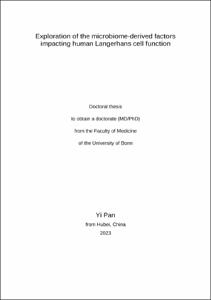Exploration of the microbiome-derived factors impacting human Langerhans cell function

Exploration of the microbiome-derived factors impacting human Langerhans cell function

| dc.contributor.advisor | Bieber, Thomas | |
| dc.contributor.author | Pan, Yi | |
| dc.date.accessioned | 2023-04-28T11:48:10Z | |
| dc.date.available | 2023-04-28T11:48:10Z | |
| dc.date.issued | 28.04.2023 | |
| dc.identifier.uri | https://hdl.handle.net/20.500.11811/10803 | |
| dc.description.abstract | Atopic dermatitis (AD) is the most common chronic inflammatory skin disease worldwide. AD skin is heavily colonized with S. aureus (S.a.) and exhibits low amounts of S. epidermidis (S.e.). In this thesis, different bacteria stimuli were used to explore their impact on the biology of in vitro generated human Langerhans cells (LCs). In study 1, both heat-killed S.a. and S.e. stimulation induced LCs maturation and migration. Furthermore, heat-killed bacteria stimulation downregulated TLRs, FcεRI and its related transcription factors PU1 and YY1. In addition, heat-killed bacteria stimulation upregulated JAK1 and JAK3 but not type I or type II cytokine receptors. At last, heat-killed bacteria induced LCs significantly to release increased proinflammatory chemokines and inflammatory cytokines. In study 2, TLR ligation induced LC maturation and migration. Furthermore, TLR ligation downregulated TLRs. In contrast, only P2C- and P3C-stimulated LCs showed decreased expression of FcεRIα and its related transcription factors PU1 and YY1, but not LPS- stimulated LCs. P3C- stimulated LCs displayed reduced expression of ELF1. In addition, all TLR ligation only influenced JAK family members but not type I or type II cytokine receptors. At last, TLR ligation induced LCs to release high amounts of proinflammatory chemokines and inflammatory cytokines. In study 3, live S.a. induced immunogenic LCs while live S.e. induced tolerogenic LCs, as shown by live imaging, flow cytometry, MLR and bead-based ELISA. Live S.a.-primed LCs induced T cells to secrete higher amounts of IL-5, IL-6, IL-9 and IL-22 compared to live S.e. stimulation. Conversely, live S.e.-primed LCs induced T cells to secrete significant levels of IL-10. In conclusion, heat-killed bacteria and live bacteria differentially interacted with LCs in inducing maturation, migration, antigen presentation and T cell polarization. The lessons learned may have significant translational consequences, potentially in the therapeutic management of AD. The use of topical therapies containing microbiota-derived elements may be able to redirect the cutaneous immune response in a way that more tolerance is achieved towards environmental allergens known to be provocative factors for the disease. | en |
| dc.language.iso | eng | |
| dc.rights | In Copyright | |
| dc.rights.uri | http://rightsstatements.org/vocab/InC/1.0/ | |
| dc.subject | Atopic dermatitis | |
| dc.subject | S. aureus | |
| dc.subject | S. epidermidis | |
| dc.subject.ddc | 610 Medizin, Gesundheit | |
| dc.title | Exploration of the microbiome-derived factors impacting human Langerhans cell function | |
| dc.type | Dissertation oder Habilitation | |
| dc.publisher.name | Universitäts- und Landesbibliothek Bonn | |
| dc.publisher.location | Bonn | |
| dc.rights.accessRights | openAccess | |
| dc.identifier.urn | https://nbn-resolving.org/urn:nbn:de:hbz:5-70678 | |
| ulbbn.pubtype | Erstveröffentlichung | |
| ulbbnediss.affiliation.name | Rheinische Friedrich-Wilhelms-Universität Bonn | |
| ulbbnediss.affiliation.location | Bonn | |
| ulbbnediss.thesis.level | Dissertation | |
| ulbbnediss.dissID | 7067 | |
| ulbbnediss.date.accepted | 21.04.2023 | |
| ulbbnediss.institute | Medizinische Fakultät / Kliniken : Klinik und Poliklinik für Dermatologie und Allergologie | |
| ulbbnediss.fakultaet | Medizinische Fakultät | |
| dc.contributor.coReferee | Kolanus, Waldemar | |
| ulbbnediss.contributor.orcid | https://orcid.org/0000-0001-6723-1370 | |
| ulbbnediss.contributor.gnd | 133333365X |
Dateien zu dieser Ressource
Das Dokument erscheint in:
-
E-Dissertationen (1939)




